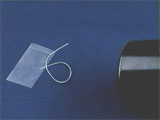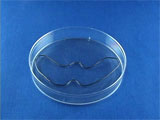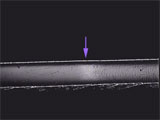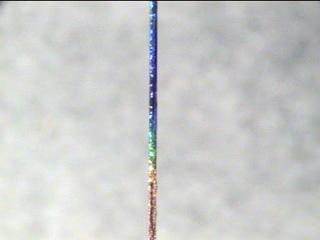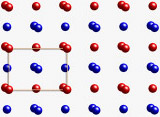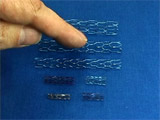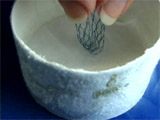
NiTi Memory Metal
NiTi has two solid-state phases and materials made of NiTi display an astonishing, counterintuitive property: they can be easily distorted into a different shape while in their low-temperature phase and upon warming into the high-temperature phase, the samples will return to their original shape.
In memory metal, nickel and titanium atoms execute an atomic ballet. Here a memory metal wire is bent and when the wire is heated in a stream of hot air the atoms return to their original positions, restoring the wire to its original shape. In memory metal, nickel and titanium atoms execute an atomic ballet. Here a memory metal wire is straightened and when the wire is heated in hot water the atoms return to their original positions, restoring the wire to its original shape. NiTi Transformation FrontT. W. Shield, P. H. Leo, W. C. C. Grebner [Crone], "Quasi-Static Extension of Shape Memory Wires under Constant Load," Acta Metallurgica, 45(1), 67-74 (1997) NiTi Transformation Front
When a NiTi wire is pulled, a phase transformation front moves through the wire. In this movie the wire has been painted with a liquid crystal to detect the temperature change that occurs during phase transformation. The wire is initially cold (black). As the transformation front moves from the top to the bottom of the image, the color changes to red at the front with a trailing rainbow of yellow-green-blue behind the front. The liquid crystal stays blue until the wire slowly cools. NiTi cell phone antenna NiTi syringe plunger Flexon eyeglass frames are made from the high temperature form of memory metal. This can be shown by lowering the temperature in liquid nitrogen to give the more easily deformed low temperature phase. Upon warming, the frames return to their original shape. (8 MB file) Solid state phase change in NiTi.
Larger movie in a new window NiTi is used to make medical devices such as the cardiovascular stents shown here. The superelastic "springy" property that this alloy exhibits above its transformation temperature (body temperature) is shown in the movie. These devices are very resilient even when severely compressed because of the superelastic property of NiTi. When cooled below its transformation temperature by liquid nitrogen, the NiTi transforms to the martensite phase and holds the new shape until it warms back up. As the stent warms the material transforms from the martensite phase (stable at low temperatures) to the austenite phase (stable at high temperatures). When it transforms to austenite it "remembers" its original shape, which is why NiTi is called a shape memory alloy. This model has an electrically heated NiTi actuator. Movement of a NiTi wire causes the wings to move.
Exploring the Nanoworld | MRSEC Nanostructured Interfaces
Copyright © 2013 The Board of Regents of the University of Wisconsin System.
This page created by George Lisensky, Beloit College. Last modified November 4, 2013 .
This page created by George Lisensky, Beloit College. Last modified November 4, 2013 .
